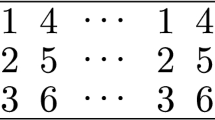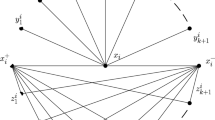Abstract
The secure domination problem, a variation of the domination problem with some important real-world applications, is considered. Very few algorithmic attempts to solve this problem have been presented in literature, and the most successful to date is a binary programming formulation which is solved using CPLEX. A new binary programming formulation is proposed here which requires fewer constraints and fewer binary variables than the existing formulation. It is implemented in CPLEX, and tested on certain families of graphs that have previously been considered in the context of secure domination. It is shown that the runtime required for the new formulation to solve the instances is significantly less than that of the existing formulation. An extension of our formulation that solves the related, but further constrained, secure connected domination problem is also given; to the best of the authors’ knowledge, this is the first such formulation in literature.

Similar content being viewed by others
References
Araki, T., & Yumoto, I. (2018). On the secure domination numbers of maximal outerplanar graphs. Discrete Applied Mathematics, 236, 23–29.
Burger, A. P., de Villiers, A. P., & van Vuuren, J. H. (2013). Two algorithms for secure graph domination. Journal of Combinatorial Mathematics and Combinatorial Computing, 85, 321–339.
Burger, A.P., de Villiers, A.P., & van Vuuren, J.H. (2013). A binary programming approach towards achieving effective graph protection. In: Proceedings of the 2013 ORSSA annual conference, ORSSA 2013, pp. 19–30.
Burger, A. P., de Villiers, A. P., & van Vuuren, J. H. (2014). A linear algorithm for secure domination in trees. Discrete Applied Mathematics, 171, 15–27.
Cabaro, A. G., & Canoy, S. R, Jr. (2015). Secure connected dominating sets in the join and composition of graphs. International Journal of Mathematical Analysis, 9(25), 1241–1248.
Cockayne, E. J., Grobler, P. J. P., Grundlingh, W. R., Munganga, J., & van Vuuren, J. H. (2005). Protection of a graph. Utilitas Mathematica, 67, 19–32.
Elloumi, S., Hudry, O., Marie, E., Martin, A., Plateau, A., & Rovedakis, S. (2018). Optimization of wireless sensor networks deployment with coverage and connectivity constraints. Annals of Operations Research,. https://doi.org/10.1007/s10479-018-2943-7.
De Jaenisch, C.F. (1862). Traité des applications de l’analyse mathématique au jeu des échecs. L’Académie Impériale Des Sciences.
Fan, N., Watson, J.P. (2012). Solving the connected dominating set problem and power dominating set problem by integer programming. In: G. Lin (Ed.) Combinatorial optimization and applications. Lecture notes in computer sciences (Vol. 7402, pp. 371–383), Berlin/Heidelberg, Springer.
Haynes, T. W., Hedetniemi, S., & Slater, P. (2013). Fundamentals of domination in graphs. Boca Raton: CRC Press.
Lad, D., Reddy, P. V. S., & Kumar, J. P. (2017). Complexity issues of variants of secure domination in graphs. Electronic Notes in Discrete Mathematics, 63, 77–84.
Merouane, H. B., & Chellali, M. (2015). On secure domination in graphs. Information Processing Letters, 115(15), 786–790.
Miller, C. E., Tucker, A. W., & Zemlin, R. A. (1960). Integer programming formulation of traveling salesman problems. Journal of ACM, 7(4), 326–329.
Pradhan, D., & Jha, A. (2018). On computing a minimum secure dominating set in block graphs. Journal of Combinatorial Optimization, 35(2), 613–631.
Sampathkumar, E., & Walikar, H. B. (1979). The connected domination number of a graph. Journal of Mathematical and Physical Sciences, 13(6), 607–613.
Van Rooji, J. M. M., & Bodlaender, H. L. (2011). Exact algorithms for dominating set. Discrete Applied Mathematics, 159(17), 2147–2164.
Wang, H., Zhao, Y., & Deng, Y. (2018). The complexity of secure domination problem in graphs. Discussiones Mathematicae Graph Theory, 38(2), 385–398.
Watkins, M. E. (1969). A theorem on tait colorings with an application to the generalized petersen graphs. Journal of Combinatorial Theory, 6, 152–164.
Winter, A. (2018). Domination, Total Domination and Secure Domination. Honours Thesis, University of South Australia.
Yuan, D. (2005). Energy-efficient broadcastig in wireless ad hoc networks: Performance benchmarking and distributed algorithms based on network connectivity characterization. In Proceedings of the 8th ACM international symposium on modeling, analysis and simulation of wireless and mobile systems, pp. 28–35.
Author information
Authors and Affiliations
Corresponding author
Additional information
Publisher's Note
Springer Nature remains neutral with regard to jurisdictional claims in published maps and institutional affiliations.
Rights and permissions
About this article
Cite this article
Burdett, R., Haythorpe, M. An improved binary programming formulation for the secure domination problem. Ann Oper Res 295, 561–573 (2020). https://doi.org/10.1007/s10479-020-03810-6
Accepted:
Published:
Issue Date:
DOI: https://doi.org/10.1007/s10479-020-03810-6




